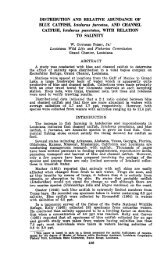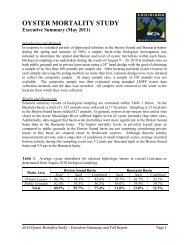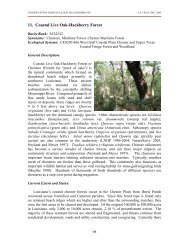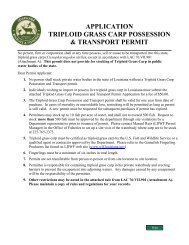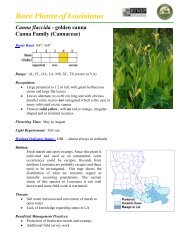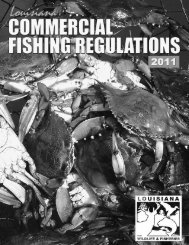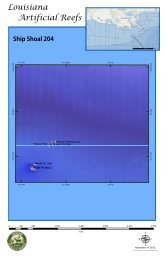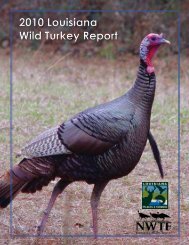Wildlife Insider Spring Summer 2010 - Louisiana Department of ...
Wildlife Insider Spring Summer 2010 - Louisiana Department of ...
Wildlife Insider Spring Summer 2010 - Louisiana Department of ...
Create successful ePaper yourself
Turn your PDF publications into a flip-book with our unique Google optimized e-Paper software.
HunterEducationat aGlanceBy John Sturgis,LDWF EducationProgram ManagerLDWF file photoNote small size <strong>of</strong> the electric clay target thrower usedduring hunter education instruction.<strong>Spring</strong>/<strong>Summer</strong> <strong>2010</strong>The <strong>Louisiana</strong> Hunter Education Programhas a 35-year history <strong>of</strong> makinghunting a safer sport in <strong>Louisiana</strong>. Begunin 1974, it has come a long way andhas gone through a number <strong>of</strong> changes tohave evolved into its present form. Theprogram was started by a handful <strong>of</strong> newlyhired staff who embarked on a mission <strong>of</strong>developing a structured hunter educationcourse, as well as recruiting and training avolunteer instructor force that now stands at1,700 strong.Methods <strong>of</strong> course delivery have progressedthrough the years. Old 16mm filmprojectors and flip charts have given wayto computerized technology. PowerPointpresentations and interactive computer programsare now the norm. Clay target throwersused for live fire instructions were solarge and heavy, they had to be towed ona utility trailer, but are now small enoughto be loaded into the back <strong>of</strong> a pickup truckby one person (pictured above). Student recordsthat were once entered into databasesby hand can now be scanned and electronicallysubmitted for storage. Students, whoonce had to contact a person by phone toregister for a hunter education course, cannow register completely on-line withouthaving to speak to a person. The internethas provided a great opportunity for advancementin hunter education. People cannow take a hunter education course on-linein the convenience <strong>of</strong> their own home, aswell as access a number <strong>of</strong> other useful resources.Knowledge <strong>of</strong> hunting incidentsthat went unconfirmed are now investigatedby trained personnel, and results are enteredinto a national database that is analyzed andused in the prevention <strong>of</strong> future hunter incidents.The <strong>Louisiana</strong> Hunter EducationProgram has expanded through the yearsin its efforts to provide advanced trainingin weapons other than shotguns and rifles.Bow and muzzleloader hunter educationcourses are <strong>of</strong>fered for those who enjoythe challenge <strong>of</strong> pursuing game with moreprimitive hunting equipment.While new technology has allowed advancementsin course delivery, some thingsdo not change. One being the crucial rolethat volunteer hunter education instructorsplay in this important program. Thebackbone <strong>of</strong> the <strong>Louisiana</strong> Hunter EducationProgram has always been its volunteerswho unselfishly dedicate countless hours <strong>of</strong>their personal time to give back to the sport<strong>of</strong> hunting. Without their service it wouldbe a futile effort, and they are to be salutedfor their accomplishments.Similarly, while we utilize new technologyand approaches to deliver our messageto meet the cultural needs <strong>of</strong> each new generation,the message is always the same becausethe basic principles <strong>of</strong> safe firearmshandling remains unchanged. No matterhow many different ways we find to teach aperson to handle a firearm safely, we strivefor the same desired results - a person whois a responsible, knowledgeable and safehunter. In hunter education, we teach whatis called the 10 commandments <strong>of</strong> firearmssafety. These 10 commandments areintended to serve as guidelines for huntersto follow to prevent a hunting incident. Ifhunters would only observe the first fourvirtually every hunting incident could beprevented. They are:1. Always point your firearms muzzle in asafe direction.2. Keep your finger <strong>of</strong>f <strong>of</strong> the trigger untilready to fire.3. Be sure <strong>of</strong> your target, what is in frontand beyond it.4. Treat all firearms as if they are loadedat all times.Remember these rules <strong>of</strong> safe firearms handling.Burn them to your memory and thinkabout every move you make with a firearmwhen it is in your hands. Have a safe andsuccessful hunting season.For More InformationSpecific information on huntereducation classes can be foundon the <strong>Louisiana</strong> <strong>Department</strong> <strong>of</strong><strong>Wildlife</strong> and Fisheries website:http://www.wlf.louisiana.gov/education/huntereducation/1





